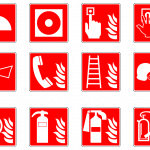Business Operations and Fire Detection System?

Fire Detection System –
Timing is everything in a fire situation. Most think during a fire emergency is the most
important time factor to consider. However, the response time after a
fire is just as critical. It is always advisable to install a
fire detection system in your business operations.
Fire Detection System Installation
This is something that should obviously be done before a potential hazard could take place.
This is the proactive part of the fire detection system, being proactive that is.
First things first, make a list on the checklist for safety detections.
They all are intertwined with fire as you can see. Make sure each of these features is up to code.
Also, make sure the equipment is working if not brand new.
Make sure their batteries, for example, are in the place of the equipment if needed.
This will reduce future headaches, especially in the event of a fire loss.
You can have some form of detection equipment, such as:
- Smoke detectors,
- Heat sensors
- Automatic sprinklers systems

Fire Detection Devices for Your Business
These fire safety devices should be installed in the buildings to ensure optimal
safety and reduce any future fire concern on that level, which would be
the detection level. The importance of these devices is not only to reduce
the potential and severity of a fire loss but the installation of these safety equipment
devices can also result in lower fire premiums. This means it pays to be safe.
These simple “lives saving techniques” can also save you money, while protecting others.
Sounds like a great union, once you look at both ends.
So, make sure to include this one on the top of your recommendation safety list,
no matter your operation.
Review – Fire Extinguisher Usage
Now that we have discussed the usage of permanent fire detection systems,
another area of concern is the portable version of them. So, let’s begin.
For all appropriate building areas to have ultimate safety levels and features,
portable fire extinguishers should be present. But before you race out there and start
purchasing them for your place of business, continue reading on.
There are a few steps you will want to take prior to placing portable fire safety devices in
your business operations. These type of extinguishers should also be reviewed by an appropriate person.
Fire Detection Specialist?
So, what exactly is a fire detection specialist anyhow? This is a person with a trained eye in disguising
between these safety devices. This is because you want to make sure you are using
the correct type of fire extinguisher for your business. This is an important element since there are different models used
for different reasons. For example, you would not want to use a dry chemical extinguisher in
the presence of electronic equipment. Why you ask. This is because the 2 do not agree, and you will be happy that
you had an advanced warning. For example, the powder-like material that is
dispensed can easily get on the electronic equipment and damage the internal components of it.
So, it’s not as though the 2 would together create an explosion, but the risk of losing
vital data on your electronic device can be just as devastating.
So, a designated area, in addition to the proper extinguishers are a must to
avoid any possible damage on this level.
Plus, it gives you peace of mind in the event of a fire or fire loss.
Pressurized Tank Safety
How do you keep pressurized tanks secured, and away from possible exposure?
This is a great question! A good plan in place should be in order.
This will help to keep all tanks in an upright position and reduce any exposure.
In addition, you will want to make sure they are properly labeled and secured
to a wall or holding rack. This way, it will prevent any accidental tipping,
which can be detrimental to these types of tanks.
This is the largest safety concern for these specialized commercial drivers.
Equipment Maintenance for your Operation
Sounds about right, maintenance as a safety preventive. Well, that’s because it is, and for good reason.
That is because all electronic and electrical equipment should be on a routine for a
regular inspection. These inspections should be used to see if there is any wear or deterioration
of the equipment. This type of maintenance plan
can spot a possibility for a fire loss if not inspected.
Inspection Overview
Only through inspections can an overview be performed. This overview will check for
any indicators or red flags, that could be possible interventions of future performance
or disaster-prone areas. Either or, awareness of the project,
prior to the situation is always helpful. Our suggestion is to incorporate a
set of eyes for this task. Have certain employees or staff members check on
the equipment and take the record for any observations that need further attention,
like potential fire safety risks. No matter your business operation, these steps should not be overlooked.
These reports, performed by different hands and eyes, can help reduce any risk in potential disasters,
such as a fire loss. These findings are jotted down and reported for future security maintenance.
Maintenance of the Fire Protection Equipment
How do you maintain the standard of protection of the equipment? This happens
through regular inspections, testing, and maintenance of fire protection equipment.
These maintenance performance tasks ensure that such equipment is functionable
when needed to be used. A suggestion to those involved in this operation is,
make a formal maintenance schedule.
Assignment & Maintenance Tracker
This schedule would be to establish for all the equipment. It would also specify which
personnel would be assigned to the maintenance program. This would help for
tracking and reporting purposes. An outlined schedule is helpful, for any
maintenance assignment. An employee categorization is an even better plan in the long run.
This can hold or show who is responsible for which reporting equipment.
Also, information can be narrowed down to one individual person,
if future communication is needed on this subject. It acts as a directional map
in the event of safety or equipment malfunction. A great organizational and tracking
tool for more than just safety purposes.

Employee Fire Control Training
This title makes sense all by itself. Fire control training seems appropriate in the
safety reduction plan of any insurance program. This training course uses
fire prevention training to improve the effectiveness of people responding
to a crisis. All employees honestly should be trained in this field. The correct operation
of this training program is paramount in the overall protection of the operation.
Just stand back and look at it from a different perspective or level.
The training course would include the operation of all the fire alarms,
fire extinguishers and other relevant fire control equipment.
This gives an edge on the fire safety measure when it comes to play regarding the equipment.
Also, your fire control program should include periodic safety meetings to discuss an
overview of the resolution. For example, actions that could be
taken in the event of a fire or potential fire risk.
Fire Evacuation Plan for Escape
We have all seen them, fire evacuation outlines or diagrams. It is a visual plan that
should be executed or followed if a fire should take place. This plan will show a
diagram of the building with all escape routes. If an escape route is locked or has
other barrier methods, then an alternative method of escape would be grounded.
This implementation of a diagramed safety fire loss plan is not just a fire reductionist plan
for saving lives and property, but also a tool for communication to assist in
the delivery of the tool itself. It is twofold in scope as you can see, plan and deliver.
Visibility of Fire Protection Equipment
A pretty self-explanatory program or plan you can say. It basically means you
should have everything visible. So, if your operations are a commercial trucking business,
then your hub areas, where all your action and logistics occur, should have proper
identification of safety equipment and fire control tools. This is an area
of a business we sometimes forget to mention. It’s because the simple act
of visibility, which might seem meniscal to the outside, is, in fact, large, and always in play.
Concluding Thoughts:
It’s important to understand where the two lines meet. So, the bottom line is visibility.
This is key to a successful plan of action. It can mean a multitude of different things,
but in the world of safety, it means bringing the right tools and plan of action
in the forefront or in view of others. This is what visibility entails.
What good is a fire loss control equipment if you cannot find the equipment, right?
Or, it is misplaced or mislabeled or stocked in an unauthorized area.
So, as you can see, the main reason can stand between the line of business visibility and not.



